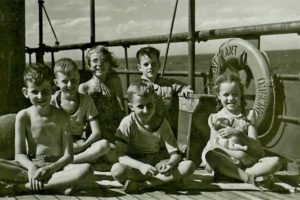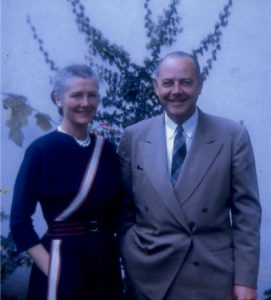A previous Vita Brevis post featured the story of how my grandfather[1] went to sea after college and eventually became a station master for Pan Am’s flying boat operations in the South Pacific. It concluded with my family dropped off in Gladstone, Australia, after being evacuated from Noumea, New Caledonia, shortly after the bombing of Pearl Harbor. At least a couple of folks wondered what happened to them after that, so here’s the rest of the story, plus a contemporary epilogue.
After several days in Gladstone – a rough-and-tumble cattle town experiencing strict water rationing – my grandparents, father,[2] and aunt[3] made their way by narrow gauge railroad to Brisbane, where they were able to take much-needed baths. The following day they took another train to Sydney, where they spent Christmas and New Year’s in a hotel before renting a flat for the duration of their stay, which they believed would be of some length. From their windows they could see the Queen Mary in the harbor, camouflaged and waiting to transport troops to the European theater.
Word suddenly came that the SS President Grant, which had escaped a bombing run while docked in Manila, was on its way. The ship sailed at midnight 12 January 1942, zig-zagging to evade any submarines as they crossed under the Sydney Harbour Bridge.
Fortunately for my father and aunt, there were several children onboard (five British boys, and a couple of Dutch girls from Indonesia) to play with, so there was fun amidst the anxiety. In fact, by the journey’s end, my aunt was speaking with a Dutch accent!
But back to that anxiety stuff. Some days into their journey, and after traveling in thick fog for more than a day, my grandfather suddenly felt the ship shift to full astern. He exited the onboard barbershop and saw the ship heading straight for a sheer, black cliff. By the time they’d stopped, the ship was so close you could have thrown a baseball from the bow to the cliff! Evidently a navigational beacon between the two main islands of New Zealand had been extinguished due to the war, and this had caused the near disaster.
Arriving in Wellington, the ship took on provisions … plus about 100 New Zealand air force personnel, making them a very “hot target” for submarines. Then they traveled for weeks without knowing their route or the expected duration of the journey, always on the lookout for enemy ships.
One morning my father and aunt rushed excitedly into their parents’ stateroom: “Mimi! Daddy! There’s a submarine outside!” My grandparents were sure that this was the end. However, it was only a rusty old Peruvian submarine that had come to escort them out of Peru’s territorial waters. Whew!! As they made their way up the coast, the Athearn family unknowingly got a glimpse of the country they would later live in for many years.
After a few more harrowing incidents, the Athearns arrived safely in San Pedro, California, on 18 February – more than a month after their departure from Sydney. My grandmother’s parents, who lived nearby in Los Angeles, were thrilled and relieved to hear that they were safe, since no one had any idea where they’d been.
Pan Am then sent train tickets for travel to San Francisco, so that my grandfather could report to work. After weeks of travel and months without a paycheck, they had no money at all!
The family soon settled in Miami, where my grandfather managed Pan Am’s wartime Air Ferries program – shuttling military aircraft through Africa to the European theater – and my grandmother taught English at a technical high school. After the war, they lived in Rio de Janeiro, Brazil, and then Lima, Peru, where my grandfather moved to Braniff Airlines.
Which brings me to a message I received a few weeks ago through ancestry.com, from a lady who was guided by a wiggling leaf on her family tree to my family tree. She recognized Folger and Marion Athearn right away as people she’d known in Peru when her father was a pilot for Braniff. We enjoyed some fun correspondence … and all because her first cousin twice removed happened to be the stepdaughter of my husband’s great-grandmother’s brother.
Notes
[1] Folger Athearn (1906–1992)
[2] Folger “Jerry” Athearn, Jr. (1934–2000)
[3] Marion “Merry” (Athearn) (Herb) Barton (b. 1936)
Share this:

About Pamela Athearn Filbert
Pamela Athearn Filbert was born in Berkeley, California, but considers herself a “native Oregonian born in exile,” since her maternal great-great-grandparents arrived via the Oregon Trail, and she herself moved to Oregon well before her second birthday. She met her husband (an actual native Oregonian whose parents lived two blocks from hers in Berkeley) in London, England. She holds a B.A. from the University of Oregon, and has worked as a newsletter and book editor in New York City and Salem, Oregon; she was most recently the college and career program coordinator at her local high school.View all posts by Pamela Athearn Filbert →

